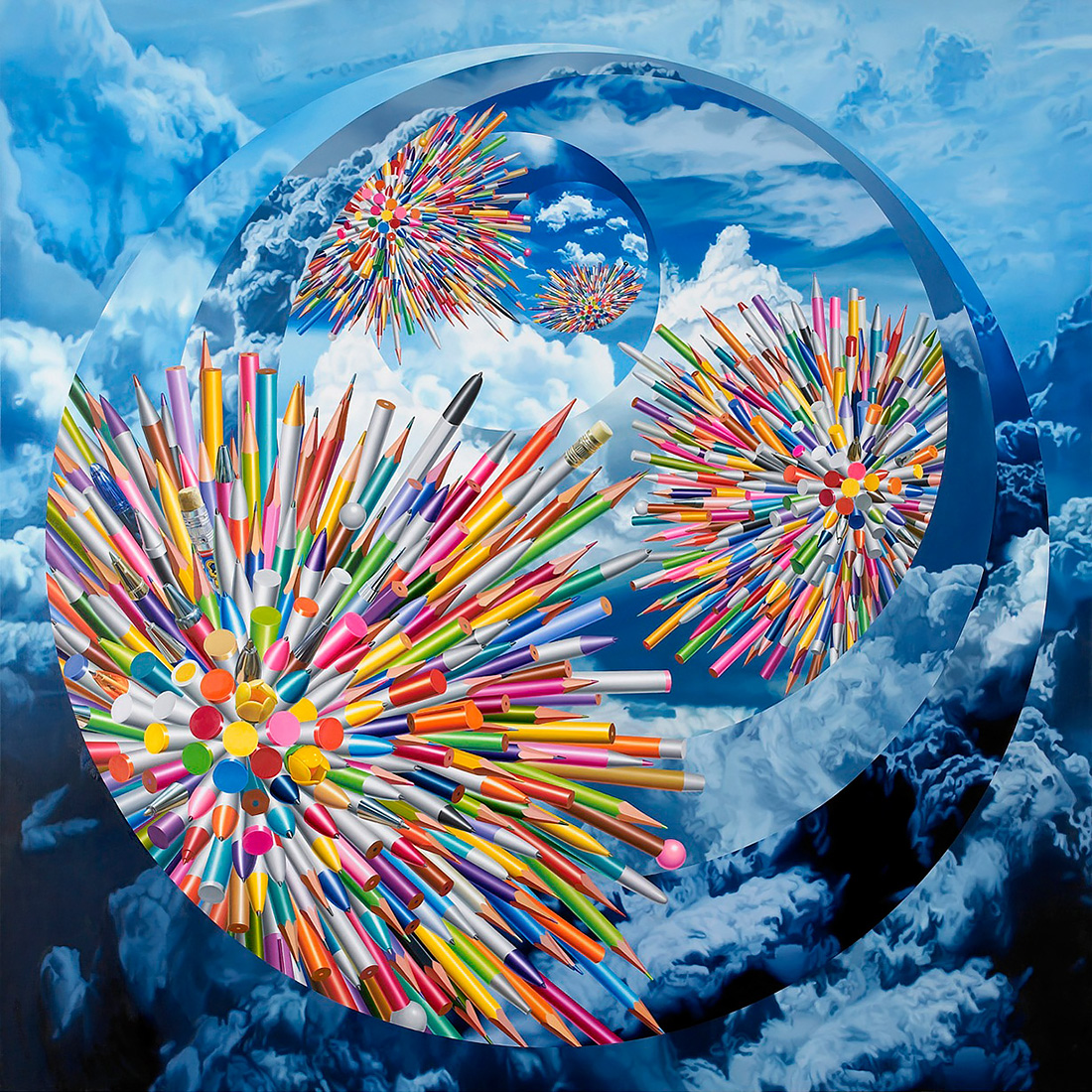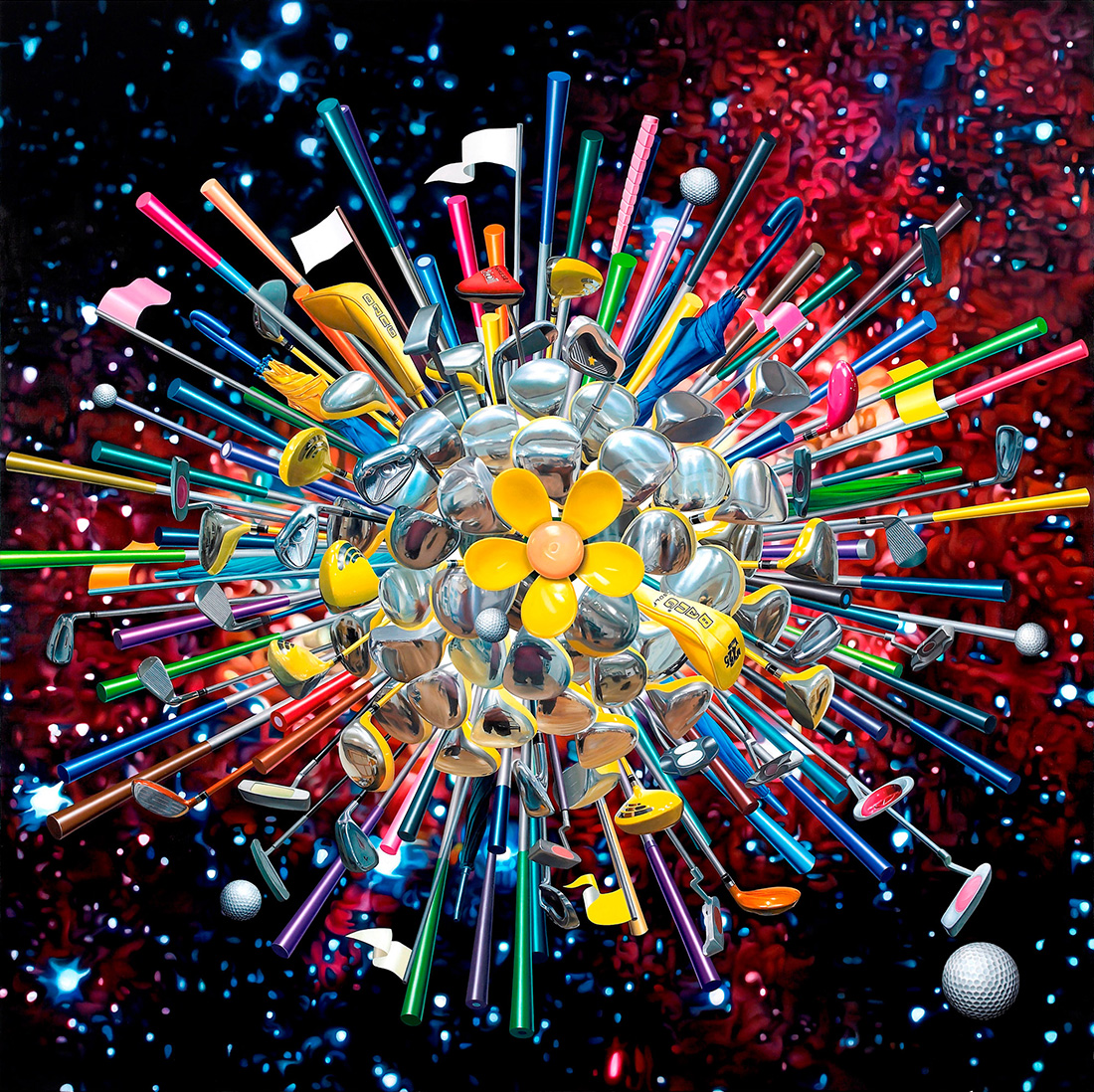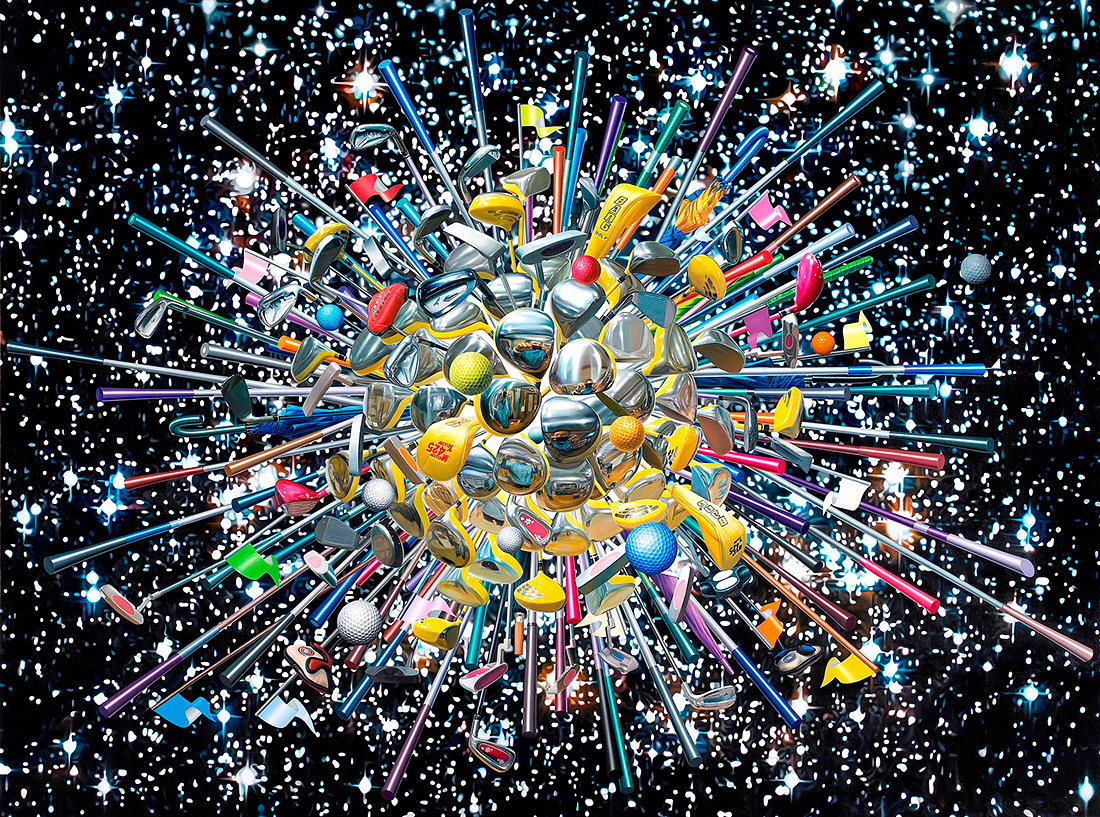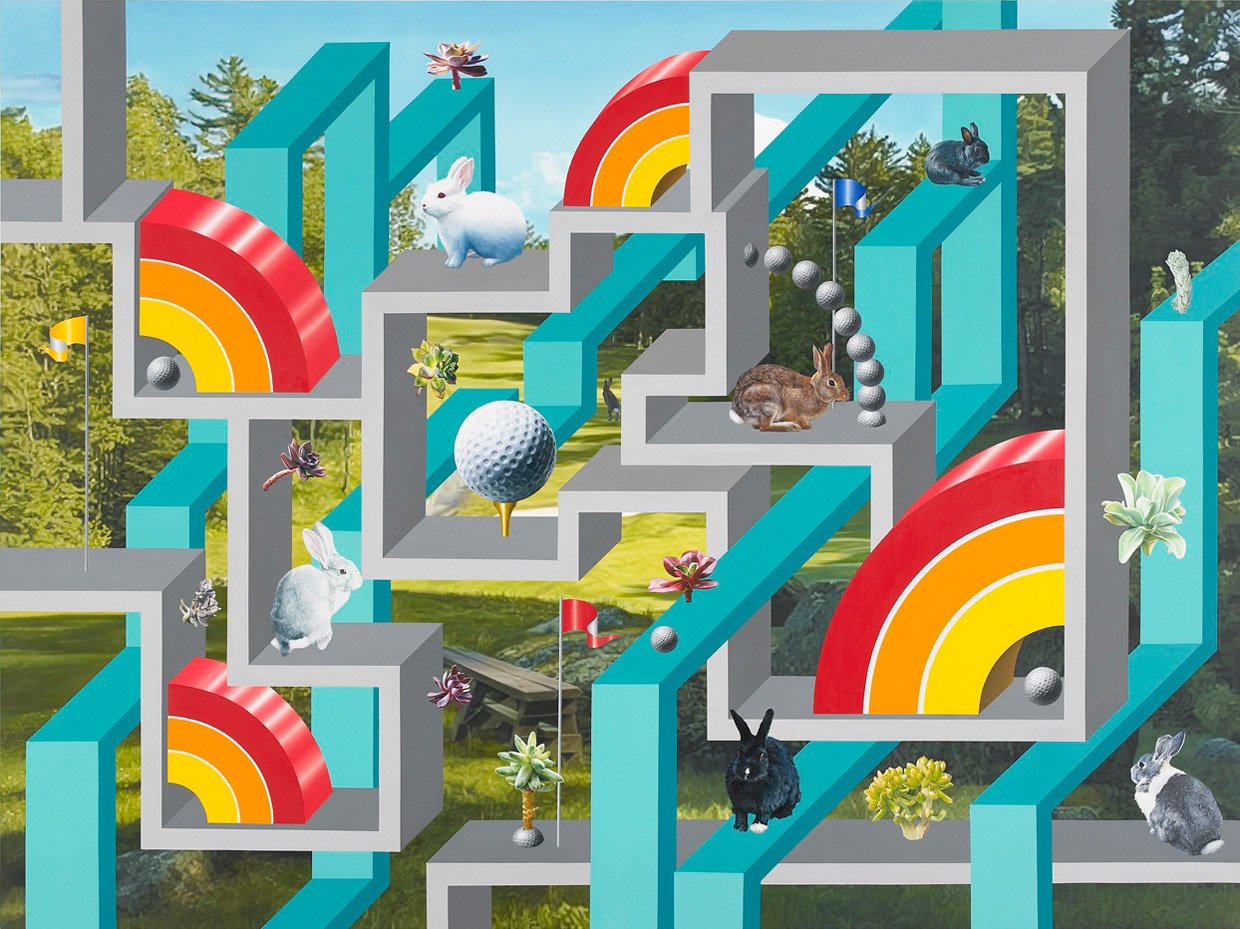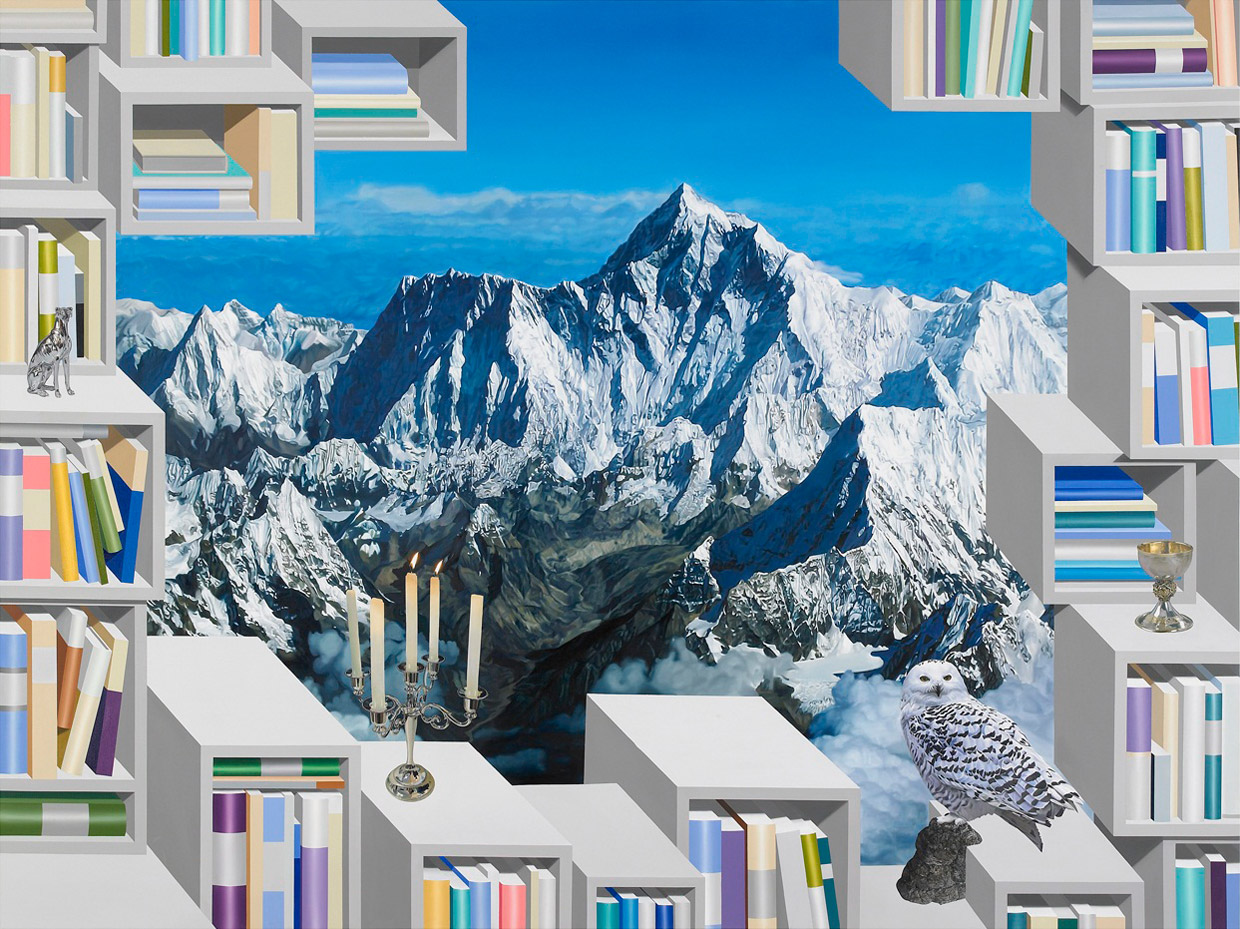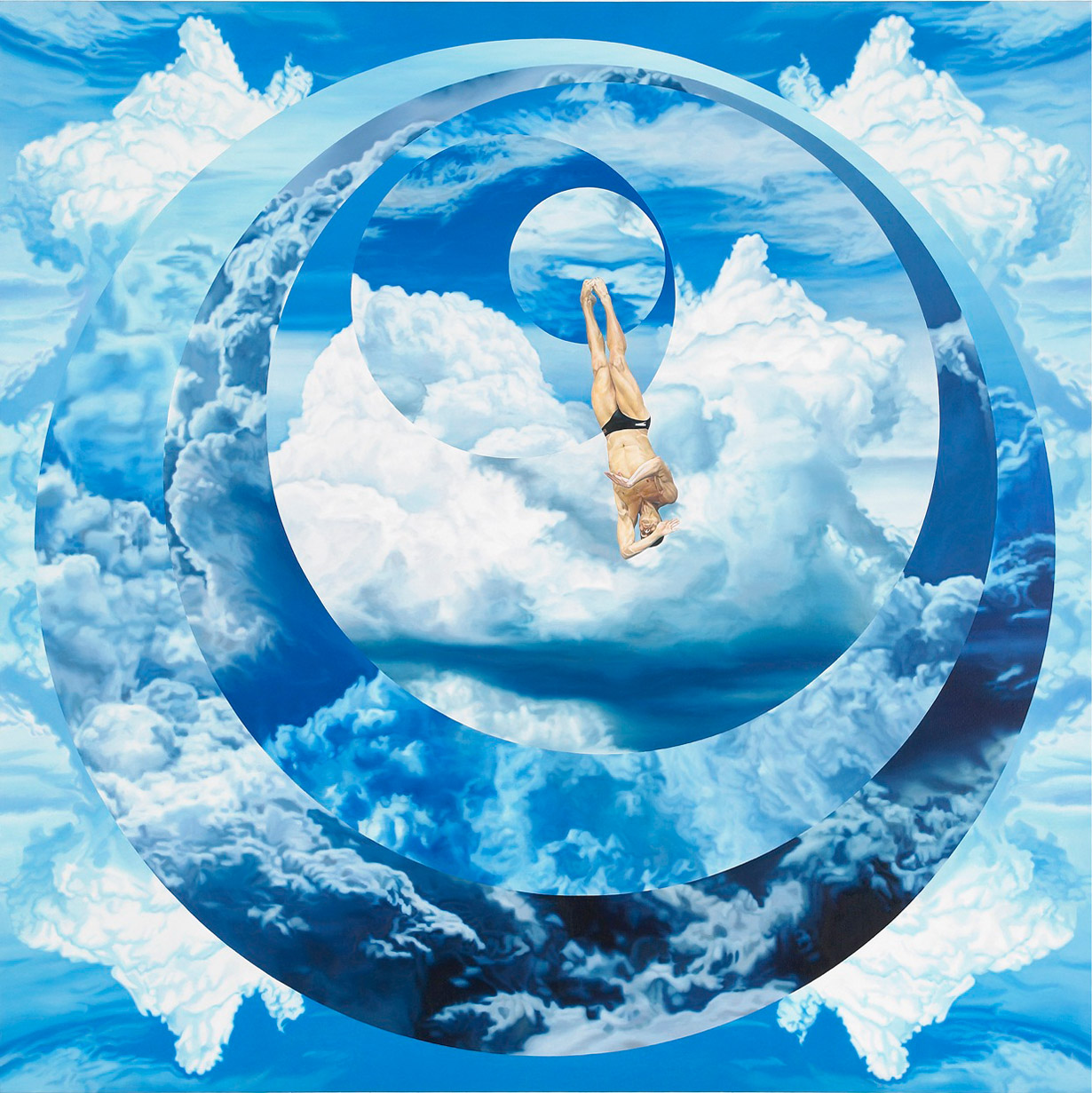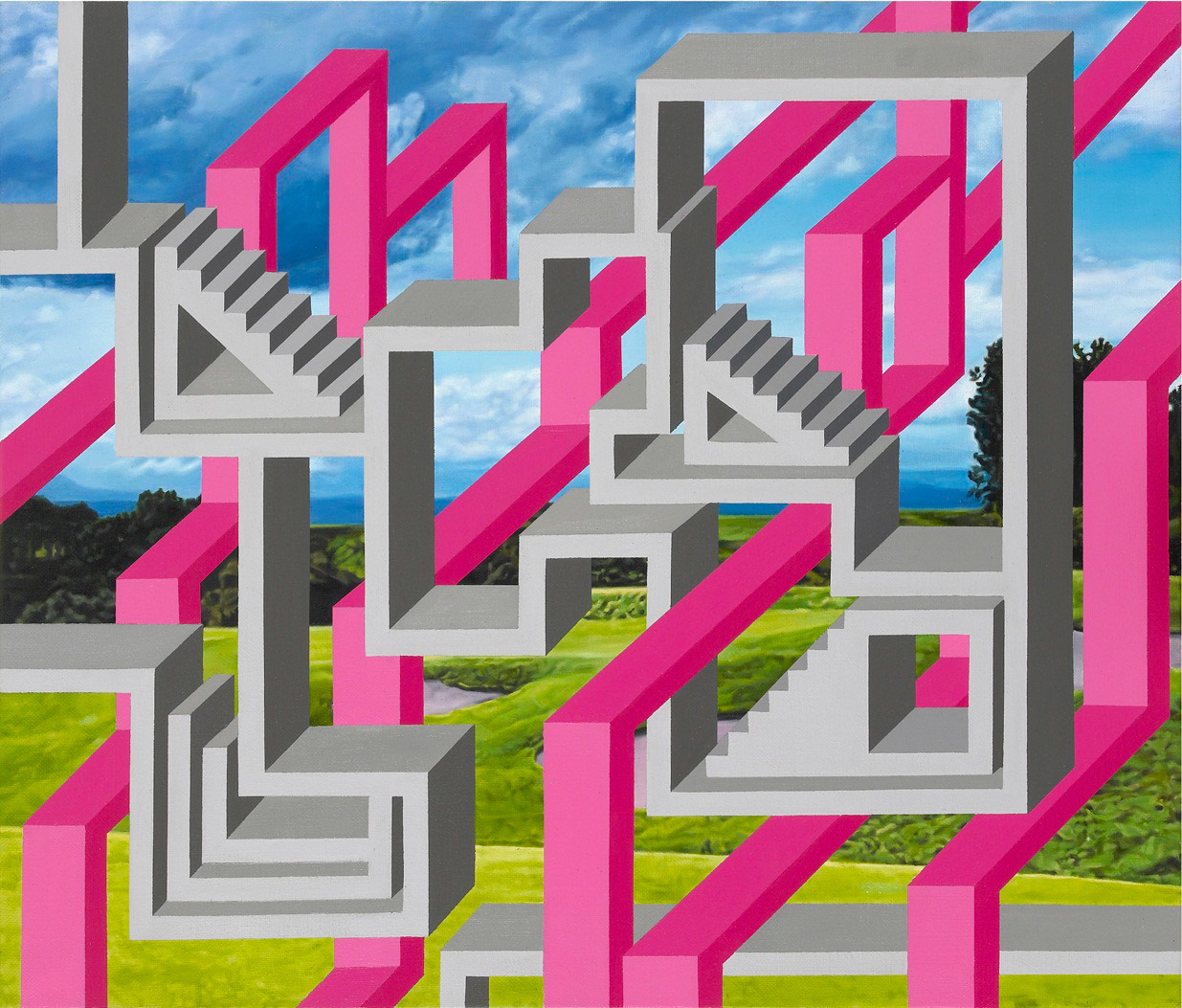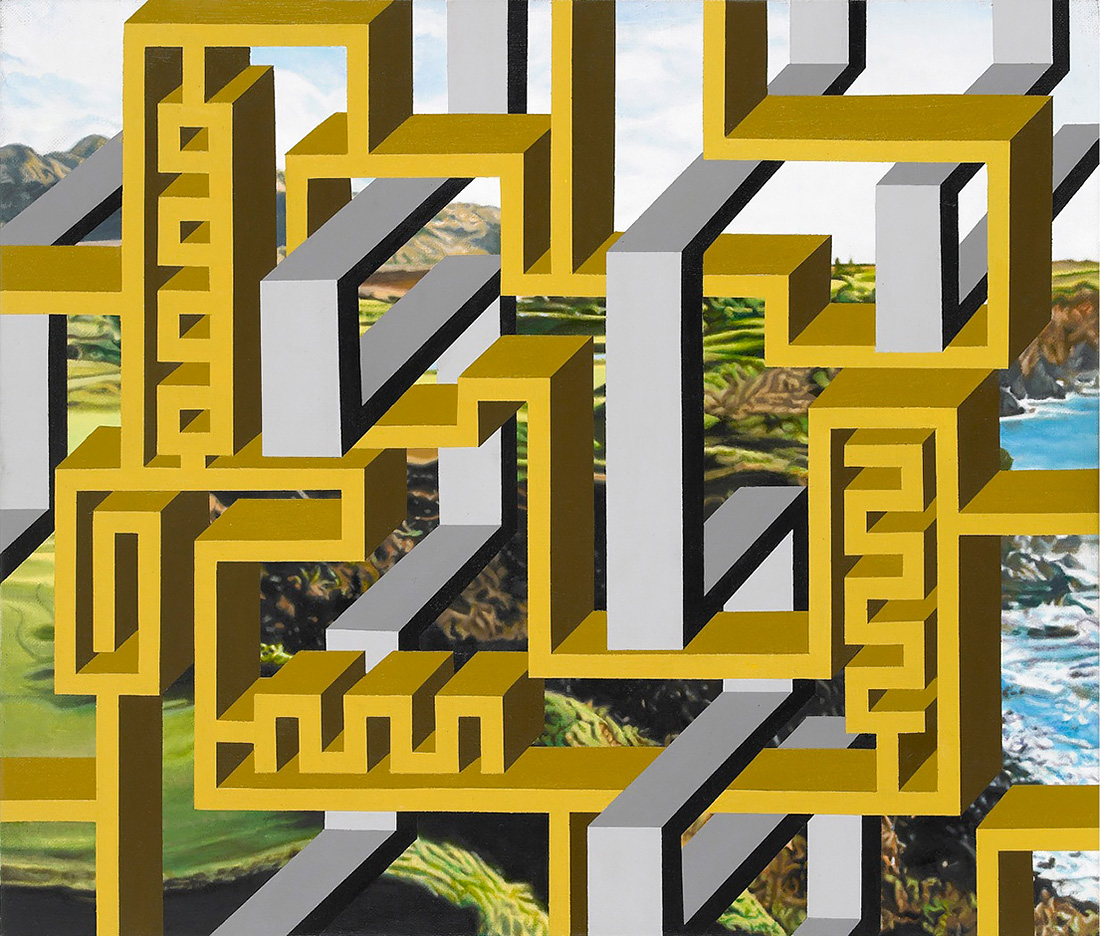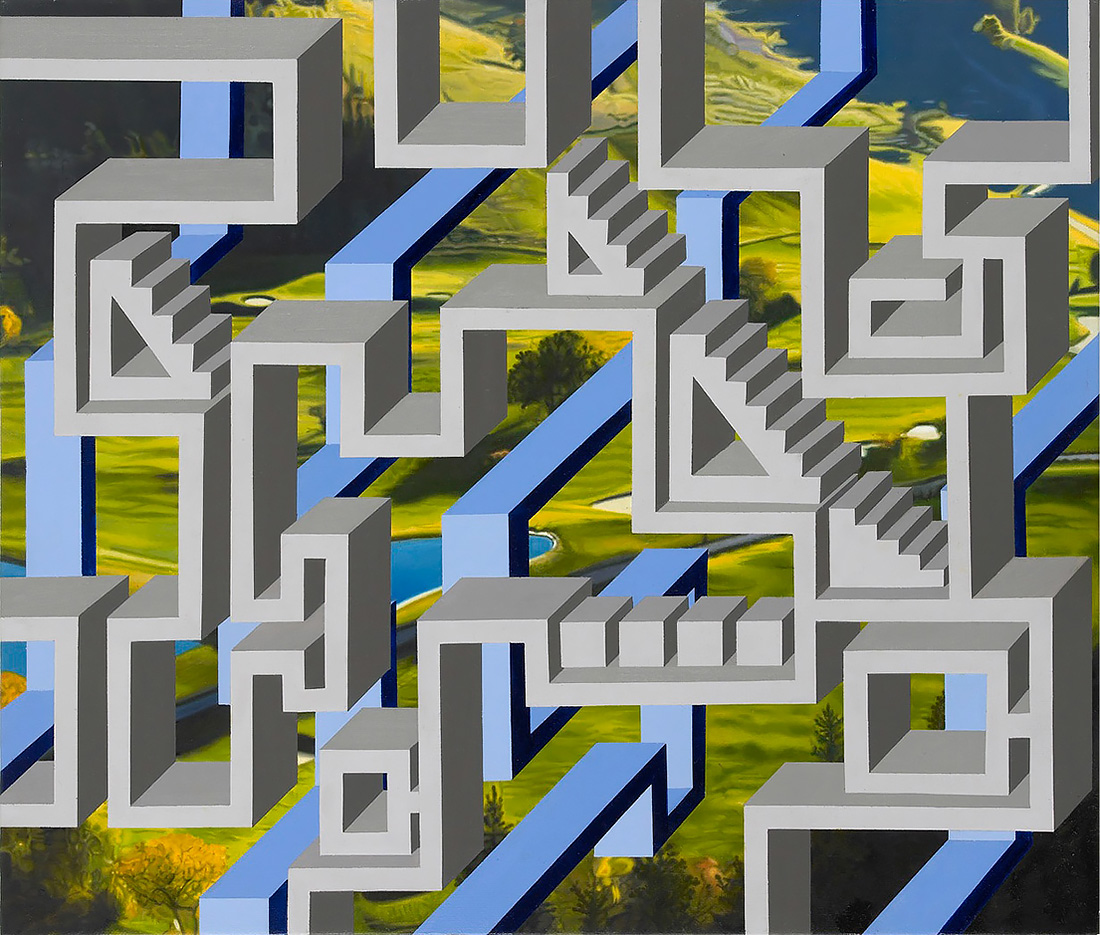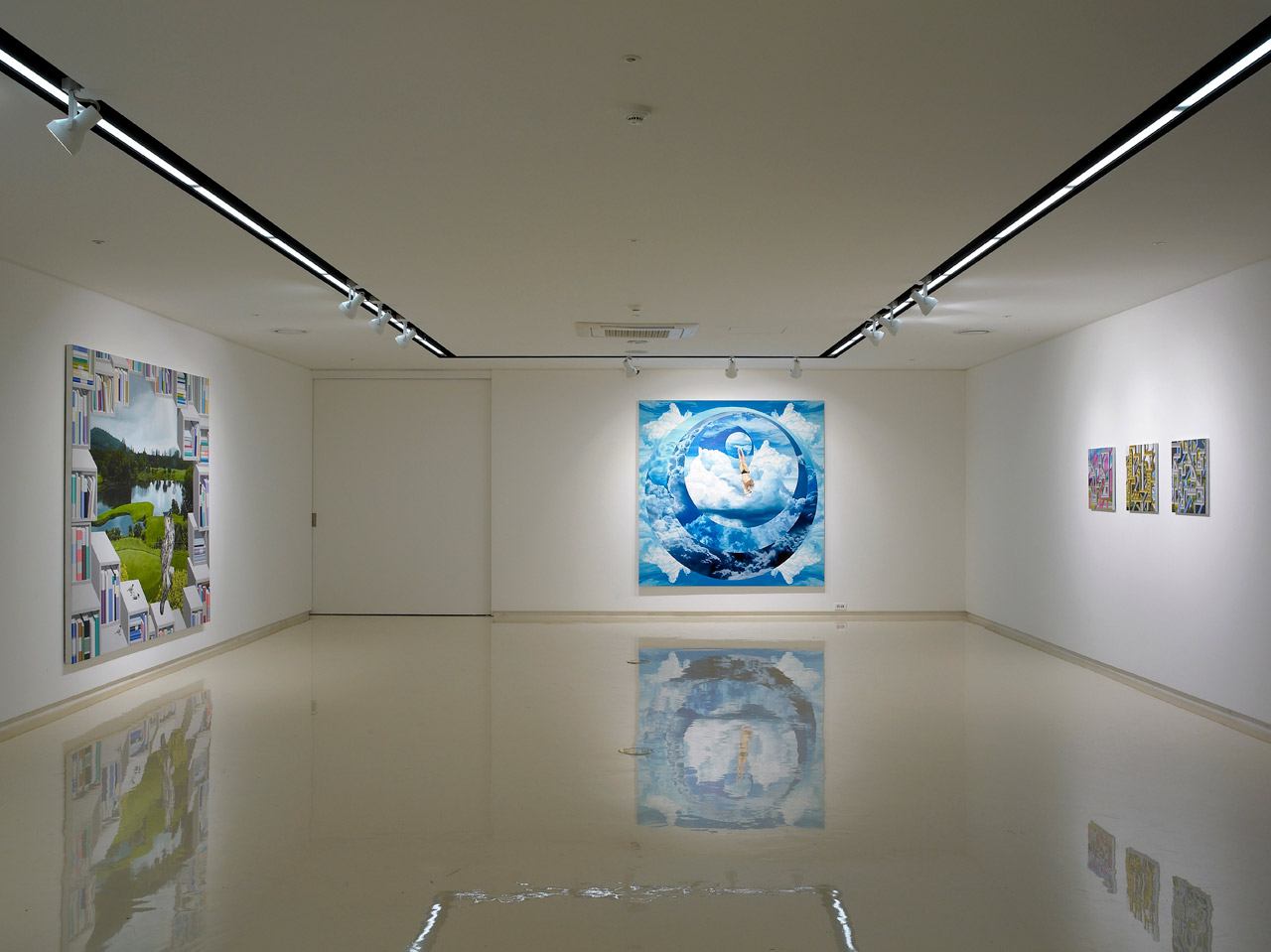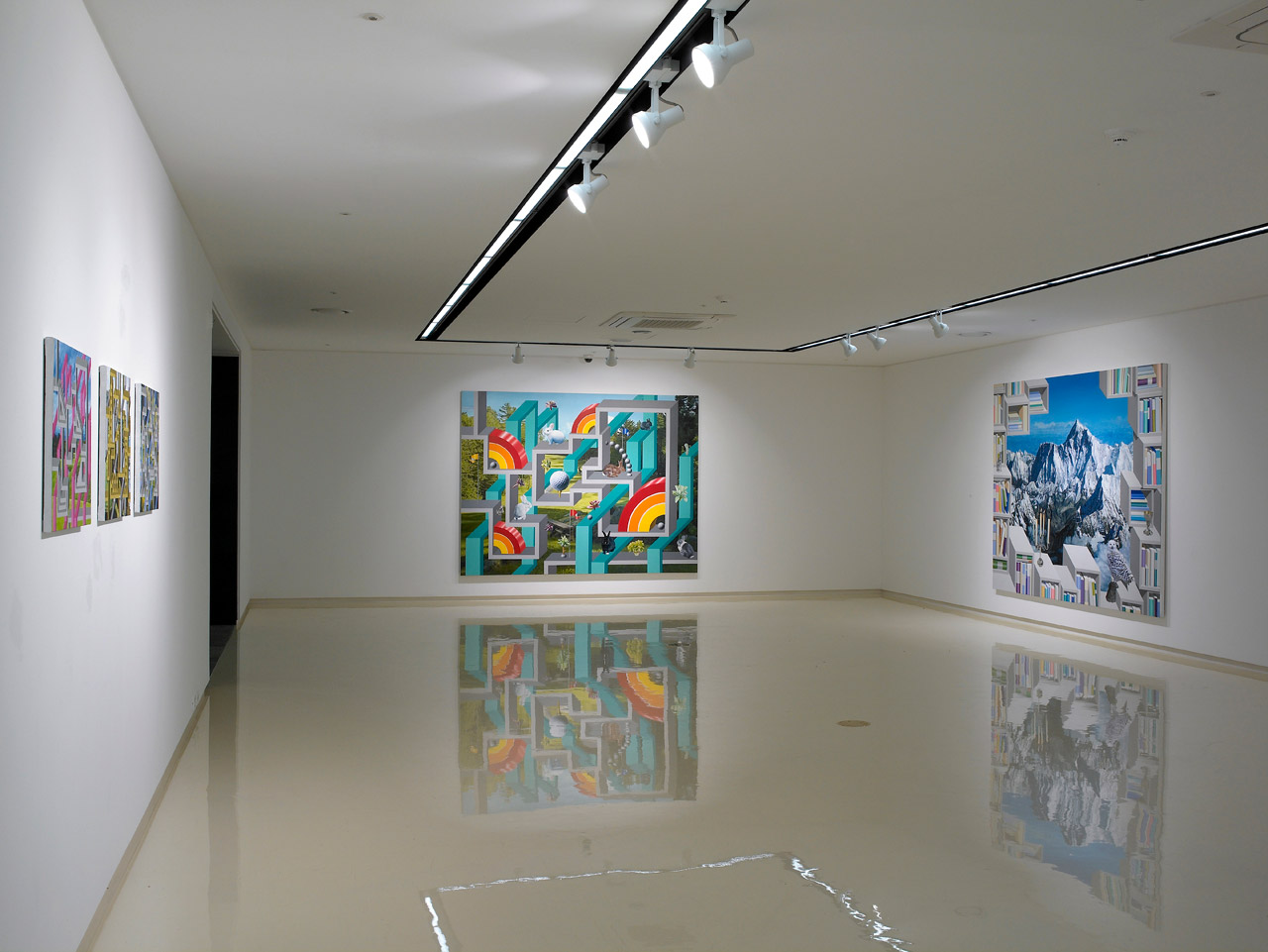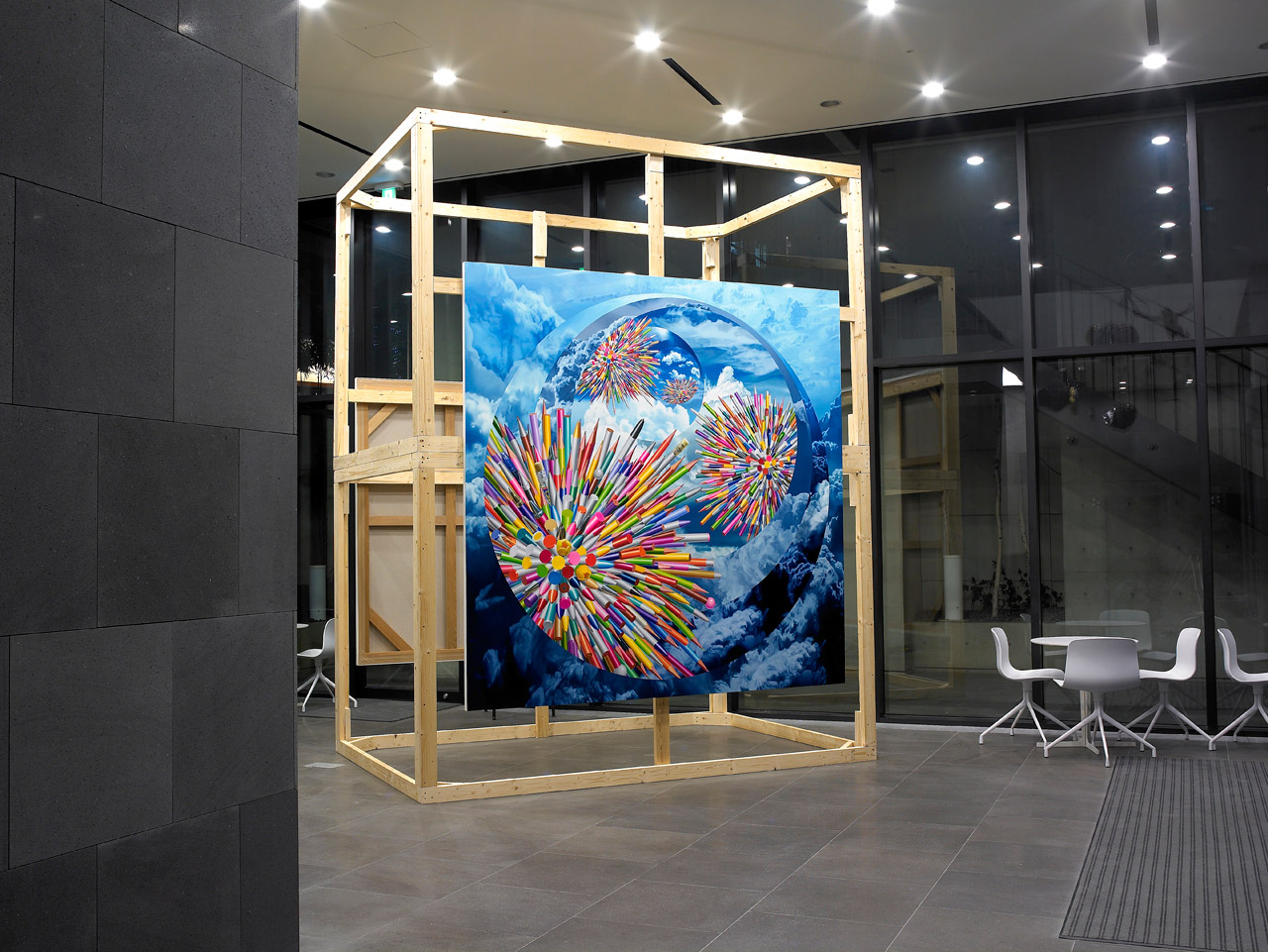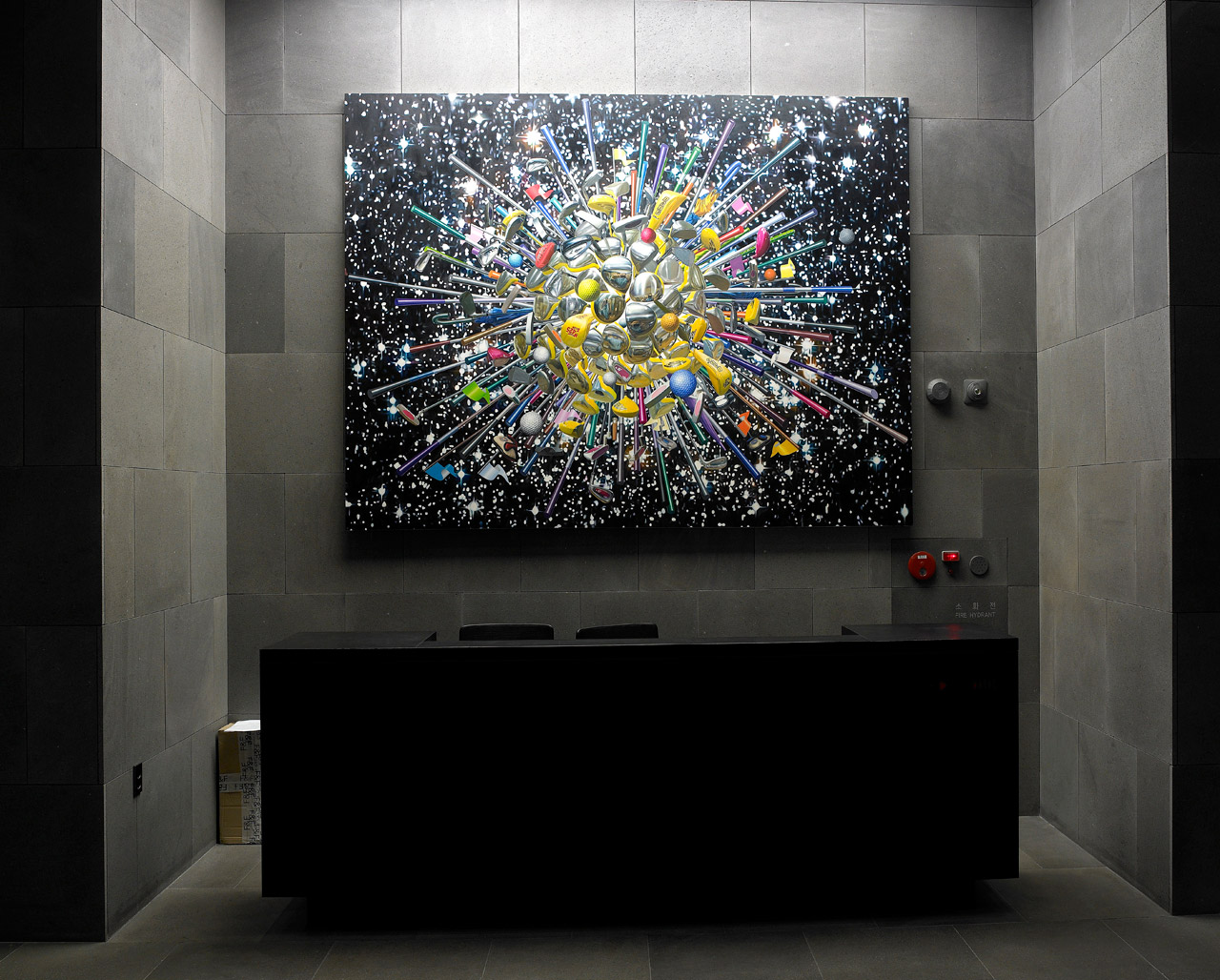Exhibitions
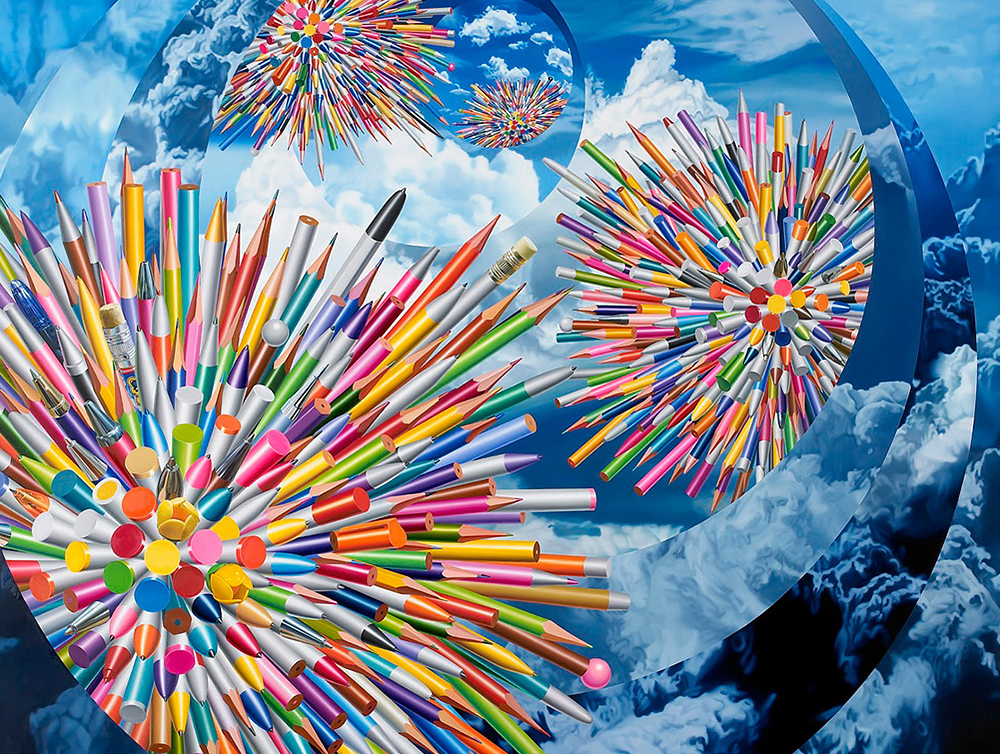
PERIGEE ARTIST #3 홍경택
Green Green Grass
2014.12.05. FRI ~
2015.01.31. SAT
I just want a perfect world
신승오(페리지 갤러리 디렉터)
홍경택은 자기 자신으로 대변되는 현대인의 집착적인 욕망을 수집된 특정한 오브제인 펜과 연필, 책, 그리고 다양한 패턴으로 보여주었고, 현대사회에서 영적인 것과 대중적인 것, 고급과 저급한 것들의 차이에 대한 의문을 제기하는 펑크음악과 유명 인사들이 결합된 훵케스트라 작업을 선보여 왔다. 작가는 우리에게 익숙해진 이런 시리즈들 외에도 다양한 페인팅과 자신의 작업을 바탕으로 만들어진 영상작업까지 그 작업의 폭을 넓혀왔다. 그리고 많은 평론가들은 그의 작업에 대해 다양한 해석들을 해왔다. 그도 그럴 것이 홍경택의 작품에서 발견되는화려한 색상과 일상적인 소재 그리고 이들이 화면 전체에 꽉 들어차 나타나는 패턴과 움직임에 유명 인사들과 관련된 이야기들은 다양한 관점에서 해석될 수 있는 요소들을 많이 가지고 있기 때문이다. 그런데 근래의 작업들은 이와는 다른 양상으로 나타나고 있다.
여기서 일단 <반추(反芻)>라는 제목의 작품에 대해 언급할 필요가 있다. 이 작품은 형식적으로는 우주를 배경으로 골프채를 패턴화된 꽃으로 그려낸 그의 전형적인 작품이다. 여기서 우리는 제목인 ‘반추’라는 단어에 주목해 볼 필요가 있다. 반추(反芻)는 어떤 일을 되풀이하여 음미하거나 생각한다는 뜻이다. 무엇을 돌아보고 음미하여 생각했을까? 아마도 이전까지의 넘치는 에너지와 색들로 가득 찬 이미지들로 채워진 본....
I just want a perfect world
By Seung Oh Shin, Perigee Gallery Director
The artist Hong Kyoung tack has demonstrated contemporary humans’ obsessive desire with specific objects such as pens, pencils, and books as well as diverse patterns. He has also introduced the Funkchestra series in which funk music and celebrities unite, questioning the difference between the spiritual and the popular, the intellectual and the uncultured in contemporary society. He has broadened the spectrum of his work from a series of his paintings and produced videos based on the series of his paintings. A number of art critics have interpreted his work in different ways. His showy colors, everyday objects, their patterns and movements filling the canvas, and narratives pertaining to celebrities having many elements to be interpreted from a diverse perspective, although his recent works are somewhat different.
First, there is a need to comment on the work titled Reflection. This painting depicting a patterned flower with golf clubs against a backdrop of space is very typical of his work. Noteworthy here is the word “reflection,” its....
신승오(페리지 갤러리 디렉터)
홍경택은 자기 자신으로 대변되는 현대인의 집착적인 욕망을 수집된 특정한 오브제인 펜과 연필, 책, 그리고 다양한 패턴으로 보여주었고, 현대사회에서 영적인 것과 대중적인 것, 고급과 저급한 것들의 차이에 대한 의문을 제기하는 펑크음악과 유명 인사들이 결합된 훵케스트라 작업을 선보여 왔다. 작가는 우리에게 익숙해진 이런 시리즈들 외에도 다양한 페인팅과 자신의 작업을 바탕으로 만들어진 영상작업까지 그 작업의 폭을 넓혀왔다. 그리고 많은 평론가들은 그의 작업에 대해 다양한 해석들을 해왔다. 그도 그럴 것이 홍경택의 작품에서 발견되는화려한 색상과 일상적인 소재 그리고 이들이 화면 전체에 꽉 들어차 나타나는 패턴과 움직임에 유명 인사들과 관련된 이야기들은 다양한 관점에서 해석될 수 있는 요소들을 많이 가지고 있기 때문이다. 그런데 근래의 작업들은 이와는 다른 양상으로 나타나고 있다.
여기서 일단 <반추(反芻)>라는 제목의 작품에 대해 언급할 필요가 있다. 이 작품은 형식적으로는 우주를 배경으로 골프채를 패턴화된 꽃으로 그려낸 그의 전형적인 작품이다. 여기서 우리는 제목인 ‘반추’라는 단어에 주목해 볼 필요가 있다. 반추(反芻)는 어떤 일을 되풀이하여 음미하거나 생각한다는 뜻이다. 무엇을 돌아보고 음미하여 생각했을까? 아마도 이전까지의 넘치는 에너지와 색들로 가득 찬 이미지들로 채워진 본인의 작업과 작업과 함께 해온 시간과 작가 자신의 내면적 변화를 되돌아보지 않았을까? 이러한 가정을 할 수 있는 근거는 이 작품 안에는 골프채에 반사된 작가의 모습과 작업실의 모습이 나타난다는 점이다. 이전까지의 작업에서 전혀 드러나지 않던 작가의 존재와 작업실의 공간이의도되었든 우연적으로 그려지게 되었는지에 상관없이 직접적으로 나타나게 된 것이다.이후의 작업에서 풍경을 바탕으로 한 작업들을 선보이고 있다는 점에서이러한 추측이 가능하다.근작들은 이전의 그의 상징같이 사용되던 일상적인 소재의 패턴이나 화려한 색이 사용되기 보다는 풍경을 기본으로 하며, 원색이 아닌 차분한 색을 사용하여 이전의 작업과는 다른 모습을 보이기 시작한다. 이는 마치 작가가 이전의 작업까지 쉴새 없이 강렬한 이미지로 자신의 에너지를 발산하는 것에집중하였다면, 이제는 마치 잠시 자신이 걸어온 길을 뒤돌아보며 숨고르기를 하는 것처럼 보인다.
홍경택의 새로운 경향을 살펴보기 전에 작가의 작업방식을 잠깐 짚고 넘어가보자. 이전의 다른 인터뷰나 글들에서보이는 작가의 개인적인 성향에서 찾아 볼 수 있는데, 작가는 최대한 규칙적으로 작업을 하며, 자신의 작업실에서 특별한 경우를 제외하고는 그 공간을 잘 벗어나지 않는다. 그에게 작업실의 공간은 자신만의 세상이며, 세상의 모든 것들을 자신만의 작은 공간 안에서 바라본다는 점에서 자신만의 소우주이다. 이는 과거에는 독특하게 보였을지 모르지만, 현대 사회에서는 많은 사람들이 세상을 직접 경험하는 것보다는 자신의 공간에서 모든 것을 읽고, 경험하고, 느낀다. 이는 마치 자신이 세상을 알기 위해 직접 그 세상으로 뛰어들어 온갖 경험을 하여 세상의 일부가 되는 것이 아니라 세상의 모든 것을 나의 공간으로 끌어들여 나만의 세상을 구축해 나가는 것으로 보인다. 이렇듯 현재의 일상적 생활방식으로 작가는 세상을 바라본다. 그렇다면 작가는 자신의 방에서 무엇을 보고 무엇을 그려내고 있는 것인가?이전의 작업들에서 홍경택이 그려내는 화려한 모습들은서글픈 환상에 지나지 않는다. 유한한 인간이 꿈꾸고 바라는 세상은 결국 죽음으로 귀결된다는 것을 사람들은 알고 있지만, 그 죽음으로 향하는 과정 속에는 다양한 욕망들이 충돌하고 갈등을 빚고 화려함 속에 어두움을 감추려 하고 있다.그가 그려낸 사물들은 다른 것들에 비할데없이 화려한 겉치장 아래 환영으로서만 살아있는 인공적인 것들이다. 이러한 이미지들을 바라보고 있으면 세상 모든 것이 욕망에 가득 차 있으며, 인간의 욕망이 미치지 않는 곳은 없으며,마치 태양처럼 우리들이 살고 있는 세상에 빛과 그림자를 동시에 내려주는 존재로 보인다.대상은 시간이 지나면서 바뀌어 왔지만 그가 이야기 하고 있는 다양한 것들의 수집과 욕망, 죽음은 항상 작품의 화려함의 뒤에 감추어져 은밀하면서도 강렬하게 우리에게 전달 되어왔다.그러나 근작에 등장하는 골프장의 풍경, 하늘, 우주, 에베레스트 산은 이전 작업들과 공통점이 없어 보이지만작가는 이러한소재들을 통해 인간의 꿈과 욕망의 대상으로서의 풍경을 선보인다. 골프장은 잘 다듬어 져 있는 디자인된 아름다운 공간이면서도 서민들의 생활과는 거리가 멀다.아직도 고급스포츠로서 골프는 일반인들에게 동경의 대상이다. 또한 골프는 비즈니스의 장소로 인식되기도 한다. 아름다운 풍경 이면에서 우리는 이러한 욕망과 집착을 찾아볼 수 있다. 그렇다면 자연은 인공적인 공간과 다른가? 그렇지 않다는 것이 현실이다. 높은산, 하늘, 우주 등 인간이 경외심을 가지고 바라보았던 자연은 항상 사람들에게 많은 영감과 꿈을 주기도 하였으며다양한 전설과 설화와 같은 이야기를 생산해 내는두려우면서도 성스러운,신비로운 존재였다. 그러나 이러한 자연은 인간에 의해어느샌가변질되어 분석되고, 파헤쳐지고, 정복해야할 대상으로, 무엇인가를 이루고 소비하기 위한 욕망의 대상으로 전락해 버렸다. 물리적으로 나눌 수 없는 하늘도 가상의 선들로 구분 짓는 것이 현재의 하늘이며, 우주에는 수많은 나라들이 경쟁적으로 인공위성들을 쏘아 올린다. 다시말하면 홍경택의 작품에 등장하는 풍경들은 더 이상 낭만적인 꿈을 꾸게 하는 풍경이 아니라 욕망의 대상으로 전락해 버린 아름다운 풍경이다.
그렇다면 사람들은 왜 자연뿐만 아니라 인공적인 풍경에서도 아름다움을 느끼고 안식을 얻는 것일까? 인간은 대상을 분류하고 범주화하고 판단하고 느끼는 인식의 체계를 가진다.사실 지금의 세상은사람에 의해규정되어 관리되는 것들로 채워져 있다 이는 자연이라고 해서 예외가 아니다. 우리는 인공적으로 만든 자연과 우리가 인정할 수 있는 우리의 상식 안에서 규정된 풍경을 사랑한다. 우리의 인식과 상식에서 벗어난 자연은 불온한 것이 되어 버린다. 그리고 우리가 규정하는 모든 것들, 그리고 우리가 관리하고 조정할 수 있는 것들에서 우리는 욕망을 발견하기도 하고 한편으로는 안식을 얻기도하며 혹은 마음의 정화를 얻기도 한다. 결국 우리는 더 이상 영혼의 눈으로 대상을 바라보기 보다는 육체의 눈을 통해이상보다는 현실을 향한 꿈을 찾는다.이렇게 오늘날 현대인들은 물질적으로는 풍요하지만 정신적으로는 더욱 더 피폐해져만 간다. 그러나 이들은 이러한 피폐한 정신을 더욱 더 감각적인 쾌락을 통해 ‘마비시키고자’ 한다. 이는 현대인의 숙명일 것이다. 따라서 우리는 인공적인 것에 익숙해지고 다듬어진 것 안에서 편안함을 느낀다. 또 한편으로 작가의 말을 빌리자면 ‘자연이라는 것이 사람이 만들어 놓은 인공적인 것이 없다면, 어떻게 우리의 마음을 치유해주고 쉴 수 있는 대상으로써 받아들여 지겠는가?’ 라는 역설도 가능하다. 세상 온 천지에 사람의 손이 닿지 않는 공간은 없다. 이렇게 한치의 틈도 없는 공간에서 우리는 그나마 사람들의 영향을 그나마 덜 받은 자연을 반대 급부적으로 그리워하는 것이다. 결국은 인공적이든 자연적인 풍경이든 모두 아이러니 하게도 사람들의 욕망에 의해 의미를 부여 받고 안식과 휴식의 대상으로서 위치를 갖는다. 이렇게 현대인들은 사람들이 만들어 놓은 유형 혹은 무형의 것들 안에서 안정을 얻고 안락함과 평화를 느끼는 것이다. 결국 홍경택의 작업은 이러한 지극히 현실적인 우리들의 모습과 환경을 사유하게 만든다.이는 미술에서도 다르지 않을 것이다. 현재의 미술은 현실인 자연을 모방하는 데에서 벗어나 예술자체의 예술을 추구해 온지 오래되었다. 작가들이 만들어내는 예술이라는 응축물은 오로지 하나의 정수만을 추구하기 위해 노력해 왔고, 과거의 예술작품들은 세상의 모든 정수들을 응축시켜 단 하나의 작품의 깊숙한 곳에 표현 해왔다. 하지만 이제는 도처에 흩어져 있는 정수를 찾아내고 수집하고 발견하고 새로이 의미를 부여하며 오히려 많은 것들을 소재로 삼고 대상화 하고 있다. 이러한 과정 속에서 예술도 이제는욕망과 집착의 산물로 전락해 버리고 있는 지도 모른다. 아마도 이는 욕망으로 바라보는 세상 다시 말해 어떤 특정한 잣대와 기준으로 모든 것을 가늠하는 지금 현재의 세계에서 통용되는 어떤 특징만을 요구하는 환경 때문일 것이다.
다시 전시 타이틀인 로 돌아와 보자.이는 위에서 살펴본 대로 강조에 강조를 통해 역설적으로 사람의 욕망으로 가득 찬 환경을 말한다. 그렇다면 이전에도 해왔던 이러한 이야기들을 왜 이전과는 다르게 풍경을 통해 보여주는가? 게다가 근작들은 이전과는 다르게 많은 패턴들이나 화려한 색상이 등장하지 않는다. 작가는 이러한 풍경들을 통해 그림을 그리면서 혹은 그림을 그려놓고 관조를 통해 자신을 되돌아보고 작가 자신이 혹은 인간들이 만들고 인식하는 완전한 세상을사유하는 대상으로 사용하고 있는 것이다. 이는 동양에서 선비들이 와유(臥遊)의 방식으로 방 안에서 산수화를 보면서 가보지 않은 곳에 대한 상상으로 가상의 공간을 가지고 사유하고 즐겼듯이, 홍경택도 자신만의 공간에 서 외부의 것들을 모두 자신 안으로 끌어 당겨 그림에 담아내고 그려내는 과정뿐만이 아니라 사유의 대상으로 바라보는 것으로 보인다. 그래서 이전과는 다르게 차분하며 서서히 음미하듯이 그려나가면서 작가 스스로가 관조와 사유를 동시에 해나가며 자신의 내부로 받아드린다. 따라서 내부의 것을 발산하기만 하는 것이 아니라 외부의 환경을 끌어들이면서 순환한다. 이런 논리로 따져본다면 과거 우리의 조상들이 산수화의 가상의 풍경을 통해 ‘속세의 번뇌에서 벗어나 사유하는 가운데 도달하는 자유’를 얻고자 했던 그림을 통한 사유의 방편들을 홍경택의 작업에서도 찾아볼 수 있다. 하지만 동양적인 산수화는 자연을 인간의 본원적 고향으로 보고, 사회의 혼란함을 벗어나기 위한 피난처로 정신적인 자유를 위해 현실을 잠시 떠나는 방법을 택하고 있다. 반면에홍경택은 동양의 산수화처럼 그림 속에 빠져 듦으로써 현실을 부정하며 속세의 번뇌에서 벗어나는 것이 아니라 그림을 대면함에 있어서 현실을 똑바로 직시하고 이를 통해 다시 자신을 돌아보게 만든다.이것이 홍경택이 회화로서 우리에게 던져주는 동시대의 우리의 관념과 이상에 가까운 가장 현실적인 장면으로, 우리의 안식처로, 혹은 우리의 사유의 대상으로써 나타나는 완전한 풍경일 것이다.지금까지 살펴본 대로 이번 전시에 보여주고 있는 기존의 패턴적인 성향과 자연을 담은 풍경의 이질적인 것들의 조합의 작업들은 기존의 작업에서 우리가 살펴볼 수 있었던작가의 개인의 편집증 적인 성향이나 수집광 적인 집착만으로자신만의 신전을 만들어가는 작가로 해석 할 수 없을 것이다. 이렇게 홍경택은 우리가 기존의 그에 대해 알고 있던 자리에 머물러 있지 않고 조금씩 또 다른 새로운 단계로 진입하고 있음을 보여준다.
By Seung Oh Shin, Perigee Gallery Director
The artist Hong Kyoung tack has demonstrated contemporary humans’ obsessive desire with specific objects such as pens, pencils, and books as well as diverse patterns. He has also introduced the Funkchestra series in which funk music and celebrities unite, questioning the difference between the spiritual and the popular, the intellectual and the uncultured in contemporary society. He has broadened the spectrum of his work from a series of his paintings and produced videos based on the series of his paintings. A number of art critics have interpreted his work in different ways. His showy colors, everyday objects, their patterns and movements filling the canvas, and narratives pertaining to celebrities having many elements to be interpreted from a diverse perspective, although his recent works are somewhat different.
First, there is a need to comment on the work titled Reflection. This painting depicting a patterned flower with golf clubs against a backdrop of space is very typical of his work. Noteworthy here is the word “reflection,” its title. The Reflection is carefully thought about appreciation of a particular subject. What did he look back on, appreciate, and ponder? Did he perhaps look back on his work full of overflowing energy and colors, the time he spent doing his work, and his inner transformation? The artist himself and his studio reflected onto the golf clubs can be grounds for this assumption. This work discloses his presence and his studio space that has never appeared in his previous pieces, whether he intended this or included it by chance. We can assume this in his later presented works based on landscapes. The basic element of his recent pieces is not a daily subject matter or flashy colors typical of his previous work but landscape and quiet colors. In his previous work he concentrates on releasing his energy tirelessly through intense imageries in his previous work, but here he seems to look back upon the path he has taken.
Before looking into his new work, we need to explore his method. According to his personal disposition found in interviews and his own statements, he works as regularly as possible and usually doesn’t leave his studio unless necessary. To the artist, his studio is his own world or microcosm. Although it was probably unique in the past, many in contemporary society read, experience, and feel from their own space rather than having firsthand experience of the world. He does not seek experiences in the outside world. He rather seems to bring all things of the world into his space, thereby building up his own world. As such, the artist sees the world from the viewpoint of his everyday life. If so, what does the artist see and depict in his studio? The splendid images he portrayed before are nothing but moody illusions. Although people are well aware that their lives will come to an end in the world they dream of, they try to conceal gloominess beneath splendor while their diverse desires collide and conflict as they proceed towards death. The images he illustrated are illusory, artificial things with incomparably showy surfaces. These images look like things that bring light and shadow together to the world, where we dwell like the sun, suggesting that everything in this world is filled with desires. As time slips by, objects have changed. In his work desire and death are always hidden under his work’s flamboyance and secretly and potently conveyed to us. His recent works featuring a golf course, the sky, the universe, and Mt. Everest seem to have nothing in common with his previous pieces. He presents landscapes as human dream and desire through this subject matter.The golf course is usually a well-designed beautiful space, but it has nothing to do with ordinary life. Golf is still considered a luxurious sport in Korea and is thus the object of admiration for the general public. A golf course is also thought of as a place for business. Such desire and obsession is hidden in a beautiful landscape. If so, is nature different from man-made space? That’s not right in reality. Nature, such as high mountains, the sky and the universe, human’s gaze at in awe has always been scary, sacred, and mysterious. Inspiring human’s as being the source of legends and stories. However, this nature has degenerated into object of analysis, conquest, and desire for consumption. The physically inseparable sky is presently divided with imaginary lines. Many countries are competitively launching satellites. The scenes in Hong’s pieces are not romantic dreams any longer but things that have degenerated into objects of desire.
If so, why do people feel beauty and find solace not only in nature but also in artificial landscapes? Humans have a system of perception in which they classify, categorize, judge, and feel objects. The world is filled with things defined and managed by humans nature is no exception. We love man-made nature and landscapes we could admit and define. Nature outside of our perception and common sense is something indecent. We discover our desire, find solace, and purify our minds through all we define, manage, and control. We see objects with our physical eyes, not spiritual eyes, seeking a dream in reality. Contemporary people today enjoy material affluence but are in spiritual poverty. This devastated spirit is further paralyzed by sensuous pleasure. They are destined to this. We feel familiar to the artificial and comfortable with the honed. To borrow his words, we can ask a paradoxical question “How can we accept nature as the object in which we can heal our hearts and take a rest without something artificial?” There is no space in the world humans cannot reach. Under these circumstance we long for nature less influenced by humans. Scenes are ironically imparted with meaning by humans whether they are artificial or natural, and they have their position as the object of rest and relaxation. Contemporary people feel stability, comfort, and peace within something visible people have made. Hong’s work makes us contemplate realistic scenes and surroundings. Art is not so different from this. Art today has long pursued art for art’s sake, breaking away from emulating nature in reality. In the past, artists sought the essence of the world and tried to condense this into just one work of art. In the present however, the artists discover and collect essences dispersed everywhere, lending new meaning to the essences. They are now objectifying more things. Art could even perhaps degenerate into the object of desire and obsession in this process. This is probably because of the environment in which some hallmark only adopted in this world where all are judged by some specific measure and standard is required.
Let’s return to the exhibition title Green, Green Grass. As reviewed above, the title paradoxically refers to the environment full of desires through its emphatic repetition. If so, does he convey such narratives through landscapes unlike his previous pieces? In addition, no flashy colors and patterns are employed in his recent works. The artist meditates through these landscapes, using them to picture a perfect world humans could make and perceive. As ancient scholars in the East meditate on and relished imaginary space or places they hadn’t visited while viewing a landscape painting in their room, Hong draws all external things into his own space and encapsulate them in his paintings, seeing them as the objects of contemplation. He embraces them in his inner world through contemplation, relishing them in a way he didn’t in his previous work. His work circulates, not only radiating the internal but also bringing in the external. In this respect, we can discover some means for thought through painting in Hong’s work. This is similar to how our ancestors tried to reach freedom while contemplating imaginary landscapes, escaping agonies in the mundane world. However, Oriental landscape painters escaped the real world for spiritual freedom, seeing nature as the underlying home of all and a haven from social confusion. In contrast, Hong does not deny reality to free him from the anguish of the world but faces reality, thereby looking back on himself. Hong’s scenes are the most realistic scenes approximating our idea and ideal. They are perhaps havens or the object of our thought and contemplation. His works on display at this exhibition display a combination of heterogeneous elements, patterns and natural scenery not found in his previous works. Therefore, we cannot define him as the artist who builds his own shrine only with his paranoiac inclination and maniacal obsession with collecting. He no longer stays in a fixed position as he proceeds to a new stage steadily.
Translated by Art and Text



